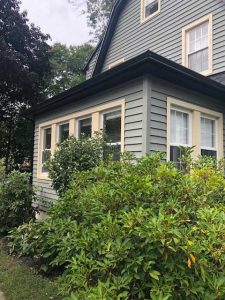Comparing Your Siding Options

Let’s take a look at the features and benefits of the different types of siding materials available for your home:
Vinyl Siding
Vinyl siding has grown in popularity because of its durability, versatility and ease of maintenance. Manufactured with polyvinyl chloride, vinyl siding is impact resistant, rigid and strong.
Vinyl siding is available in a broad palate of colors, as well as a limited range of patterns.
Vinyl siding also is available in many profiles, including horizontal and vertical panels, shakes, scallops, shingles, fish scale, traditional lap, Dutch lap and beaded designs in various widths.
With the ability to withstand high winds (certified up to 110 mph or higher) and a composition that resists heat, cold and moisture, vinyl siding retains its looks over time. And vinyl siding never ever needs paint. The only maintenance it requires is a simple wash with a soft cloth and garden hose.
Fiber Cement Siding
For those who want the appearance of wood siding without the hassles and costs associated with it, fiber cement siding is the best choice. Available in a variety of textures, fiber cement siding is more durable than wood. It’s also termite-resistant, water-resistant, and non-combustible and warranted to last fifty years.
Fiber cement siding is composed of cement, sand and cellulose fiber that has been cured with pressurized steam to increase its strength and dimensional stability. The fiber reinforces the product and prevents cracking. This siding product will protect your home from rot, fire, wind and insects.
An advantage of fiber cement siding is its attractiveness and variety of styles that have embossed wood grained texture, stucco or smooth finish. These products are combined with various types of vinyl trim to block the weather. Vinyl ventilation accessories may also be utilized and painted as you wish.
Another benefit of fiber cement siding is the virtually unlimited choice of colors provided by water-based acrylic paint, which grips these products very well and doesn’t peel because the products do not expand and contract like wood. Paint typically lasts up to 15 years. Stains may also be applied to fiber cement.
Wood Siding
Wood is a traditional siding material, either in shakes (shingles) or clapboard form. While it isn’t as common in recent years, wood siding was used on houses for hundreds of years. While attractive to look at, wood siding generally comes without a warranty, requires frequent scraping and painting, and regular maintenance, particularly in regions with extremes of moisture and temperature. Other issues associated with wood include: warping, chipping, sanding, termites, rotting, moisture damage, flammability, and limited insulation value.
Aluminum Siding
Once the “king” of replacement siding, aluminum has rapidly lost ground to more modern materials. Aluminum siding doesn’t rot, offers low maintenance, and it’s relatively easy to keep clean. But it can dent and fade.
Up and Above’s team of New Jersey siding professionals will provide a FREE in-home consult and estimate in order to help you when you are choosing siding for your home.
Get a FREE Estimate
Call Up and Above today at (973) 300-0636 for a FREE in-home consultation and estimate. Or simply complete and submit our request form and we’ll contact you within one business day.
